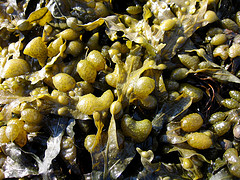
When I’m thirsty, I often fancy a cool drink of green algae, filled with Spirulina, a vitamin-and protein-packed beverage resembling pond scum that’s promoted as an immune-boosting elixir. I think of algae as benign or beneficial: clinging to a damp tree trunk, like the primitive one-celled Protococcus; as a source of biodiesel, aka oilgae; or scattered over the sea shore, like bladderwrack, a rubbery species that I seem to recall dragging home as a souvenir from seaside holidays in Brighton lo these many years ago. (That’s the English Brighton, where the beaches are covered in pebbles, the climate is typically overcast, and the locals spend chilly summer afternoons burrowed in their beach huts, or “chalets” imbibing tea and admiring each others’ poodles.)
So imagine my concern when I learned that scientists at Teikyo University in Tokyo have identified a new and unusual species of pathogenic algae that causes human skin infections. Unlike most algae, which use photosynthesis to fix sunlight, water and carbon dioxide into sugars and oxygen, these microorganisms, newly named Prototheca cutis, belong to a family of non-photosynthesizing algae that usually live in sewage and soil.
Koichi Makimura and his team at the university’s Institute of Medical Mycology isolated the algae from a chronic ulcer on the forearm of a 57-year-old man who “does not touch the soil or domestic animals in daily life,” although he had been treated for two different types of cancer. Prototheca algae, “ubiquitous detritus inhabitants,” have been known to cause infections in immuno-compromised humans by entering open wounds; a related species is known to cause mastitis, an inflammation of the milk-secreting udder of the dairy cow.
Since so few algal infections have been reported in humans, there’s no established protocol for treating flesh-eating algae, according to Makimura. Further research into these pathogenic algae could have benefits for the cattle industry, however, since Prototheca-induced mastitis costs the dairy industry millions of pounds each year, says Makimura’s colleague Kazuo Satoh. Cheese manufacturers might also be happy with a cure for algal-induced mastitis: milk produced by cattle with mastitis contains high levels of white blood cells known to most of us as pus.
Photo courtesy of Vår Resa
I was bored until i’ve found your website, interesting posts
And I am eating the algae… It is not possible, at least when I think of it as of plant having chlorophyll – it doesn’t need anything else to leave. Why would it eat flesh?
Why do Venus fly traps eat flies?